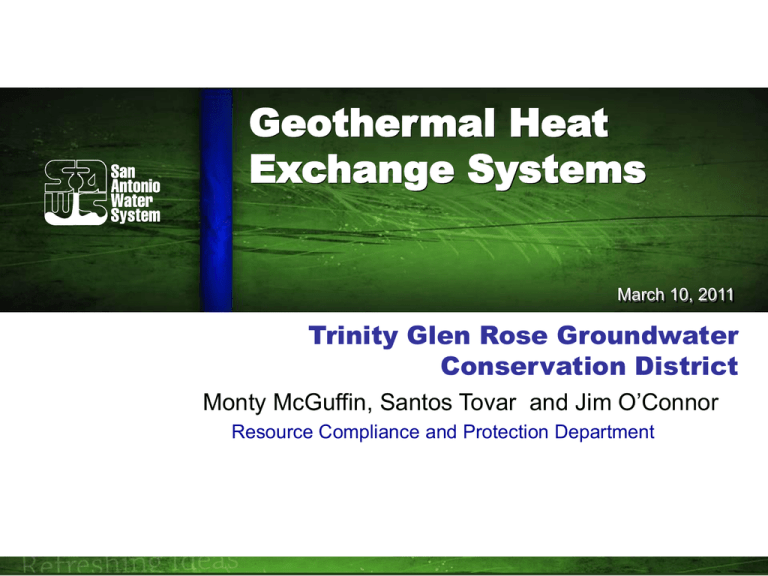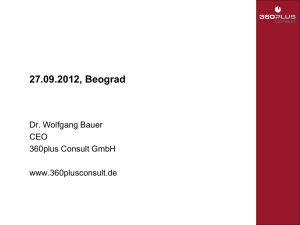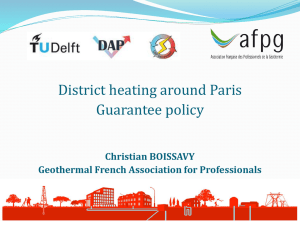Refreshing Idea - Trinity Glen Rose GCD
advertisement

Geothermal Heat Exchange Systems March 10, 2011 Trinity Glen Rose Groundwater Conservation District Monty McGuffin, Santos Tovar and Jim O’Connor Resource Compliance and Protection Department Page 2 Geothermal Heat Exchange Known by a variety of other names; – Geothermal Heat Pump, – Ground Source Heat Pump, – Ground Heat Pump, – Geoexchange, – Earth-Coupled, – Earth Energy, – Water-Source Heat Pumps, March 10, 2011 Geothermal Heat Exchange Page 3 What is Geothermal Heat Exchange? Instead of having outside coils exchange heat with the air (like standard heat pump units), the geothermal heat exchanger is a central heating and/or cooling system that pumps heat to or from the ground. It uses the earth as a heat source (in the winter) or a heat sink (in the summer). This design takes advantage of the moderate temperatures in the ground to boost efficiency and reduce the operational costs of heating and cooling systems. March 10, 2011 Geothermal Heat Exchange Page 4 Geothermal Heat Exchange System March 10, 2011 Geothermal Heat Exchange Page 5 How Geothermal Heat Exchange Works • These systems have a heat exchanger that facilitates heat transfer between the outside coil and a liquid. In the case of Kinder Ranch Elementary School, this will be Edwards Water. A pump circulates the water through buried pipes, where it is heated (winter) or cooled (summer) by the earth. • Ground loop piping is typically made of high-density polyethylene (HDPE) which is the industries preferred material. Closed loops use relatively small pipe sizes for the portion of the loop that exchanges heat with the ground, typically ranging from 3/4 to 2 inches. They can be buried in the earth in either of two ways: – vertical bore holes or horizontal trenches. When using the hole method, one or more 6-inch diameter holes are drilled to a depth of 200 - 300 feet. In each hole, a pipe leads down and then loops back up to the surface, providing as much area as possible for heat transfer to take place. Typically, one borehole is needed for each ton of air conditioning/heating capacity. • Both methods require good contact between the pipe and the ground, so the holes or trenches are generally back filled with material like grout or fine soil. If multiple holes or trenches are dug, they are kept at least 15 feet apart. . March 10, 2011 Geothermal Heat Exchange Page 6 March 10, 2011 Geothermal Heat Exchange Page 7 Vertical Closed Loop Installation • The drilling equipment for vertical borehole excavation for the Kinder Ranch Elementary School was an air rotary rig, this type of rig uses air that is pumped down the rotating drill stem to remove the cutting from the borehole. • A thermally-enhanced grout formulation with a higher ratio of sand to bentonite in the grout mixture (typically 100 to 300 pounds of sand per 50 pounds of bentonite) is used to seal the looped piping. • Drilling cost for ground loop installation are typically not as high as for water well drilling, since logging and completion procedures are not usually required. March 10, 2011 Geothermal Heat Exchange Page 8 Optional Steel Casing Air in Cuttings out •Roller Cone Bit March 10, 2011 Geothermal Heat Exchange Page 9 March 10, 2011 Geothermal Heat Exchange Page 10 March 10, 2011 Geothermal Heat Exchange Page 11 Vertical Loop Piping The most common configuration for the vertical loop piping element in the drilled bore is a U-tube, where a 180-bend fitting has been factory fused to join two lengths of HDPE pipe, and this inserted into the borehole March 10, 2011 Geothermal Heat Exchange Page 12 U-tube March 10, 2011 Geothermal Heat Exchange Page 13 Arrangement in Series or Parallel • Multiple closed ground loops can be arranged in series, parallel, or a combination of both. – In series systems, the working fluid can take only one path through the loop, – In parallel systems the fluid can take two or more paths through the circuit. • Note that parallel arrangements use a reverse rather than direct return to the building so that all parallel flow paths are of equal length, helping to ensure a balanced flow distribution. • Large commercial and institutional buildings such as schools usually employ parallel loops March 10, 2011 Geothermal Heat Exchange Page 14 Closed Loops Arrangement Series arrangement of multiple closed loops Parallel arrangement of multiple closed loops March 10, 2011 Geothermal Heat Exchange Page 15 Kinder Ranch Elementary March 10, 2011 Geothermal Heat Exchange Page 16 Kinder Ranch Elementary Construction of Geothermal Vault March 10, 2011 Geothermal Heat Exchange Page 17 Different Types of Geothermal Systems Closed Looped Vertical System Closed Looped Horizontal (trench) System Open Looped Vertical Water Well System Closed Looped Pond System March 10, 2011 Geothermal Heat Exchange Page 18 Permitting 1997 revisions to City Code to address Geothermal wells •Sec. 34-567. Permit for drilling new well required. •(a) It shall be unlawful for anyone to drill, maintain, or otherwise construct or have constructed, any new water well, or any other artificial excavation to explore for or produce groundwater, or injection wells for the purpose of a earthcoupled heat exchange system, within the City of San Antonio or SAWS Water Quality Division. This section shall not apply to: (1) monitoring wells and test wells with a depth of less than fifty (50) feet; (2) blast holes in quarries and mines; and (3) wells or excavations for the exploration or production of oil, gas, or minerals, unless, without regard to the original purpose, the well is used as a source of water. •(b) All drilling or construction of water wells, and injection wells for the purpose of an earth-coupled heat exchange system, shall be done in strict compliance with the terms of the well drilling permit, the SAWS Water Well Permitting Procedures, and 30 TAC, Chapter 238. •(c) In addition to the requirements of paragraphs (a) and (b) of this section, any water well which will penetrate the Edwards Aquifer shall be drilled and maintained in strict compliance with 30 TAC, Sections 213 et seq., as amended. This paragraph does not apply to injection wells for the purpose of an earth-coupled heat exchange system. •(d) To preserve the water quality of the aquifer, the construction of any bore hole, injection well for the purpose of an earth-coupled heat exchange system, or water well for the purpose of an earth-coupled heat exchange system located over the Edwards Aquifer Recharge Zone and Transition Zone shall be prohibited. •(e) An open system, geothermal well that draws water from an aquifer and is circulated through the heat exchange system or geothermal wells which inject water into an aquifer will not be permitted within the limits of the City of San Antonio and within SAWS Water Quality Division. March 10, 2011 Geothermal Heat Exchange Page 19 Permitting • SAWS – Permit fee covers the Geothermal System in whole ($200) • TGR – Permit fee is $350 per bore-hole • EAA – Permit fee is collected on each bore-hole ($25 per hole drilled) typically a pass-through permit is required March 10, 2011 Geothermal Heat Exchange Geothermal Heat Exchange Systems March 10, 2011 Trinity Glen Rose Groundwater Conservation District Monty McGuffin, Santos Tovar and Jim O’Connor Resource Compliance and Protection Department








